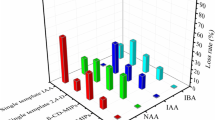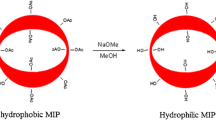Abstract
A cost-effective and eco-friendly approach for extraction and clean-up of sinapic acid was developed via the use of molecularly imprinted polymers (MIPs). Acetonitrile/methanol (5:1) was used as the porogenic solvent system, sinapic acid as the template, methacrylic acid as the functional monomer and ethylene glycol dimethacrylate as the cross-linking agent were used to prepare MIPs via precipitation polymerization. A series of MIPs were synthesized with variable template: monomer: cross-linker mole ratios: 1:4:20, 1:8:20 and 1:8:32. Polymers were characterized by complementary methods: scanning electron microscopy (SEM), dynamic light scattering (DLS), gas adsorption analysis, infrared absorption spectroscopy (FT-IR) and thermogravimetric analysis (TGA). The batch rebinding experiments were conducted to evaluate polymer performance in terms of relative binding affinity towards the template. The initial concentration and solution pH strongly affect the binding capacity of polymers in aqueous media. Moreover, the fabricated MIPs were successfully applied for extraction of sinapic acid from rapeseed meal extract.

A schematic of molecularly imprinted polymer for extraction of sinapic acid from aqueous solutions










Similar content being viewed by others
References
Danquah MK, Aruei RC, Wilson LD (2018) Phenolic pollutant uptake properties of molecular templated polymers containing β-cyclodextrin. J Phys Chem 122(17):4748–4757
Kibechu RW, Mamo MA, Msagati TAM, Sampath S, Mambab BB (2014) Synthesis and application of reduced graphene oxide and molecularly imprinted polymers composite in chemo sensor for trichloroacetic acid detection in aqueous solution. Phys Chem Earth 76–78:49–53
Suwanwong Y, Kulkeratiyut S, Prachayasittikul V, Boonpangrak S (2014) Effects of polymerization methods and functional monomers on curcumin imprinted polymer properties. Sep Sci Technol 49:1086–1095
Lee S-H, Doong R-A (2012) Adsorption and selective recognition of 17ß-estradiol by molecularly imprinted polymers. J Polym Res 19. https://doi.org/10.1007/s10965-012-9939-9
Parisi OI, Cirillo G, Curcio M, Puoci F, Iemma F, Spizzirri UG, Picci N (2010) Surface modifications of molecularly imprinted polymers for improved template recognition in water media. J Polym Res 17:355–362
Yang W-L, Huang S-M, Wu Q-Z, He J-F (2014) Properties evaluation and separation application of naringin-imprinted polymers prepared by a covalent imprinting method based on boronate ester. J Polym Res 21(4). https://doi.org/10.1007/s10965-014-0383-x
Ahmad AL, Lah NFC, Low SC (2018) Configuration of molecular imprinted polymer for electrochemical atrazine detection. J Polym Res 25
Mathew D, Thomas B, Devaky KS (2019) Design, synthesis and characterization of enzyme-analogue-built polymer catalysts as artificial hydrolases. Artificial Cells, Nanomedicine, and Biotechnology 47(1):1149–1172
Sinha AS, Khandavilli U, O'Connor E, Deadman BJ, Maguire AR, Lawrence SE (2015) Novel co-crystals of the nutraceutical sinapic acid. CrystEngComm 17:4832–4841
Nićiforović N, Abramovič H (2014) Sinapic acid and its derivatives: natural sources and bioactivity. Compr Rev Food Sci Food Saf 13(1):34–51
Quinn L, Gray SG, Meaney S, Finn S, Kenny O, Hayes M (2017) Sinapinic and protocatechuic acids found in rapeseed: isolation, characterisation and potential benefits for human health as functional food ingredients. Irish Journal of Agricultural and Food Research 56:104–119
Biorefineries, Springer International Publishing, Switzerland 2019
Flourat AL, Willig G, Teixeira ARS, Allais F (2019) Eco-friendly extraction of sinapine from residues of mustard production. Front Sustain Food Syst 3. https://doi.org/10.3389/fsufs.2019.00012
Sinichi S, Siañez AVL, Diosady LL (2019) Recovery of phenolic compounds from the by-products of yellow mustard protein isolation. Food Res Int 115:460–466
Sharma S, Sharma AK, Verma S, Dodiya HS (2014) Edible oil refinery waste water treatment by using effluent treatment plant. International Journal of Chemical Studies, International Journal of Chemical Studies 2(3):36–42
Soto ML, Moure A, Domínguez H, Parajo JC (2011) Recovery, concentration and purification of phenolic compounds by adsorption: a review. J Food Eng 105:1–27
Kraljic K, Škevin D, Barišic L, Kovacevic M, Obranovic M, Jurcevic I (2015) Changes in 4-vinylsyringol and other phenolics during rapeseed oil refining. Food Chem 187:236–242
Huang Y-J, Chang R, Zhu Q-J (2018) Synthesis and characterization of a molecularly imprinted polymer of spermidine and the exploration of its molecular recognition properties. Polymers 10(12). https://doi.org/10.3390/polym10121389
Jianfeng H, Lan L, Guilan Y, Qinying D (2006) Preparation, characterization and properties studies of quinine-imprinted polymer in the aqueous phase. Frontiers of Chemistry in China 2:211–216
Lu Y, Zhu Y, Zhang Y, Wang K (2019) Synthesizing vitamin E molecularly imprinted polymers via precipitation polymerization. Journal of Chemical Engineering Data 64(3):1045–1050
Ma L, Tang L, Li R-S, Huang Y-P, Liu Z-S (2015) Water-compatible molecularly imprinted polymers prepared using metal-organic gel as porogen. RSC Advances 5:84601–84609
Smyk B (2002) Fluorescence study of sinapic acid interaction with bovine serum albumin and egg albumin. J Fluoresc 13(4):349–356
Pardeshi S, Singh SK (2016) Precipitation polymerization: A versatile tool for preparing Molecularly Imprinted Polymer beads for chromatography applications. RSC Advances 6:23525–23536
Edwin J, Romano F, So RC, Donne SW, Holdsworth CI (2016) Preparation and binding evaluation of histamine-imprinted microspheres via conventional thermal and RAFT-mediated free- radical polymerization. ACS Omega 1:518–531
Barros LAd, Pereira LA, Custódiob R, Rath S (2014) A novel computational approach for development of highly selective fenitrothion imprinted polymer: theoretical predictions and experimental validations. Journal of the Brazilian Chemical Society 25(4):619–628
Pluhar B, Zienerb U, Mizaikoff B (2013) Surface imprinting of pepsin via miniemulsion polymerization. J Mater Chem B 1:5489–5495
Zayas H, Holdsworth CI, Bowyerb MC, McCluskey A (2014) Evaluation of 4-substituted styrenes as functional monomers for the synthesis of theophyllinespecific molecularly imprinted polymers. Organic & Biomolecular Chemistry 12:6994–7003
Parisi OI, Ruffo M, Malivindi R, Vattimo AF, Pezzi V, Puoci F (2020) Molecularly imprinted polymers (MIPs) as theranostic systems for sunitinib controlled release and self-monitoring in cancer therapy. Pharmaceutics 12(1). https://doi.org/10.3390/pharmaceutics12010041
Trotta F, Caldera F, Cavalli R, Soster M, Riedo C, Biasizzo M, Barretta GU, Balzano F, Brunella V (2016) Molecularly imprinted cyclodextrin nanosponges for the controlled delivery of L-DOPA: perspectives for the treatment of Parkinson’s disease. Expert Opinion on Drug Delivery 13:1671–1680
Booker K, Holdsworth CI, Bowyer M, Mccluskey A (2011) Ionic liquids as porogens in the synthesis of molecularly imprinted polymers, in: S. Handy (Ed.), Applications of Ionic Liquids in Science and Technology. InTech 197–212
Yue J, Wang Z, Chen J, Zheng M, Wang Q, Lou X (2019) Investigation of pore structure characteristics and adsorption characteristics of coals with different destruction types. Adsorption Science & Technology 7-8:623–648
Lanfredi S, Nobre MAL, Poon PS, Matos J (2020) Hybrid material based on an amorphous-carbon matrix and ZnO/Zn for the solar photocatalytic degradation of basic blue 41. Molecules 25(1). https://doi.org/10.3390/molecules25010096
Murray A, Örmeci B (2018) Competitive effects of humic acid and wastewater on adsorption of Methylene Blue dye by activated carbon and non-imprinted polymers. Int J Environ Sci 66:310–317
Jiang L, Lu R, Ye L (2019) Towards detection of glycoproteins using molecularly imprinted nanoparticles and boronic acid-modified fluorescent probe. Polymers 11(1):173
Yoon S-K, Lee J-C, Lee S, Choi S-H, Kim H-J, Park H-J, Kang H-D (2006) Synthesis of molecularly imprinted polymer (MIP) by radiation-induced polymerization and separation of ferulic acid from rice oil using MIP-packed column. Analytical Science & Technology 19(3):218–225
Zhang W, She X, Wang L, Fan H, Zhou Q, Huang X, Tang JZ (2017) Preparation, characterization and application of a molecularly imprinted polymer for selective recognition of sulpiride. Materials 10(5). https://doi.org/10.3390/ma10050475
Fathi Til R, Alizadeh-Khaledabad M, Mohammadi R, Pirsaa S, Wilson LD (2020) Molecular imprinted polymers for the controlled uptake of sinapic acid from aqueous media. Food and Function 11:895–906
Jiang D, Sun X, Zhang Y (2012) Preparation and application of acrylamide molecularly imprinted composite solid-phase extraction materials. Anal Methods 4:3760–3766
Chow ALJ, Bhawani SA (2016) Synthesis and characterization of molecular imprinting polymer microspheres of cinnamic acid: extraction of cinnamic acid from spiked blood plasma. International Journal of Polymer Science Volume 2016. https://doi.org/10.1155/2016/5671507
Granado VLV, Rudnitskaya A, Oliveira J, Gomes MTSdR (2012) Design of molecularly imprinted polymers for diphenylamine sensing. Talanta 94:133–139
Douglas Kinghorn Y-WCA, Pan L (2010) Natural products as sweeteners and sweetness modifiers. In: Mander H-WLL (ed) Comprehensive natural products II: chemistry and biology. Elsevier Science, Oxford, U.K.
Zhao W-R, Kang T-F, Lu L-P, Cheng S-Y (2018) Magnetic surface molecularly imprinted poly(3-aminophenylboronic acid) for selective capture and determination of diethylstilbestrol. RSC Adv 8:13129–13141
Dai C, Zhang J, Zhang Y, Zhou X, Liu S (2013) Application of molecularly imprinted polymers to selective removal of clofibric acid from water. PLoS One 8(10). https://doi.org/10.1371/journal.pone.0078167
Sánchez-Polo M, Gala IV, López-Peñalver JJ, Rivera-utrilla J (2015) Molecular imprinted polymer to remove tetracycline from aqueous solutions. Microporous Mesoporous Mater 203:32–40
Michailof C, Manesiotis P, Panayiotou C (2008) Synthesis of caffeic acid and p-hydroxybenzoic acid molecularly imprinted polymers and their application for the selective extraction of polyphenols from olive mill waste waters. J Chromatogr A 1182:25–33
Rodrigues ASS, Aguiar APd, Aguiarb MRMPd, Maria LCdS (2007) Quaternization reaction of 2-vinylpyridine and 4-vinylpyridine network copolymers for 4-nitrophenol adsorption. Journal of the Brazilian Chemical Society 18(2):431–436
Farrington K, Regan F (2007) Investigation of the nature of MIP recognition: the development and characterisation of a MIP for ibuprofen. Biosens Bioelectron 22:1138–1146
Yu P, Sun Q, Tan Z, Meng M, Pan J, Yan Y, Li C (2015) Magnetic molecularly imprinted polymer beads obtained by suspension polymerization for the adsorption of 2,4,6-trichlorophenol from an aqueous solution in a fixed-bed column. Adsorption Science & Technology 33(3):321–336
Surikumaran H, Mohamad S, Sarih NM (2014) Molecular imprinted polymer of methacrylic acid functionalised β-cyclodextrin for selective removal of 2,4-dichlorophenol. Int J Mol Sci 15:6111–6136
Liu X, Wu F, Au C, Tao Q, Pi M, Zhang W (2018) Synthesis of molecularly imprinted polymer by suspension polymerization for selective extraction of p-hydroxybenzoic acid from water. J Appl Polym Sci 136(3). https://doi.org/10.1002/app.46984
Asman S, Yusof NA, Abdullah AH, Haron MJ (2011) Synthesis and characterization of a molecularly imprinted polymer for methylene blue. Asian J Chem 23(11):4786–4794
Javanbakht M, Namjumanesh MH, Akbari-adergani B (2009) Molecularly imprinted solid-phase extraction for the selective determination of bromhexine in human serum and urine with high performance liquid chromatography. Talanta 80:133–138
Díaz-Alvarez M, Turiel E, Martín-Esteban A (2019) Molecularly imprinted polymer monolith containing magnetic nanoparticles for the stir-bar sorptive extraction of thiabendazole and carbendazim from orange samples. Anal Chim Acta 1045:117–122
Ye H, Chen X, Feng Z (2017) Preparations of magnetic molecularly imprinted polymer for selective recognition and determination of 4-methylimidazole in soft beverage by high performance liquid chromatography. Adsorption Science & Technology 35(1–2):37–54
Acknowledgements
Authors gratefully acknowledge the financial supports from the University of Tabriz and the Urmia University. LDW acknowledges the support of the Government of Canada through the Natural Sciences and Engineering Research Council of Canada (NSERC; Discovery Grant RGPIN 2016-06197). R. Fathi Til acknowledges the support of Urmia University through the VRS program at the University of Saskatchewan for facilitation of this collaborative research project.
Author information
Authors and Affiliations
Corresponding authors
Ethics declarations
Conflict of interest
The authors declare that they have no competing interests.
Additional information
Publisher’s note
Springer Nature remains neutral with regard to jurisdictional claims in published maps and institutional affiliations.
Electronic supplementary material
ESM 1
(DOCX 848 kb)
Rights and permissions
About this article
Cite this article
Fathi Til, R., Mohammadi, R., Alizadeh-Khaledabad, M. et al. Synthesis, characterization and adsorption behavior of sinapic acid imprinted polymer via precipitation polymerization. J Polym Res 27, 235 (2020). https://doi.org/10.1007/s10965-020-02213-2
Published:
DOI: https://doi.org/10.1007/s10965-020-02213-2




